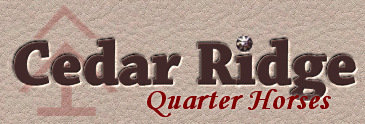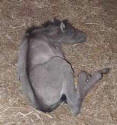

Dun Factor vs Countershading
My foal has stripes. Is it dun factor, or countershading?
|
"Countershading" is a form of striping that is probably a remnant of primitive camouflage, but which is not the same as dun striping. It is not a dilution, and is often only visible on young horses.
Some horses will retain some countershading for their whole lives, but it is far less distinct and contrasting with surrounding colors when compared to dun factor striping...usually. ;-) 2016 update: UC Davis has information about possible genetic causes of stripes that are not dun factor. When you reach the bottom of this page, you'll get a little more information and a link about this.
There is often a great difficulty determining a horse's color when it comes to dilution genes, especially as foals. Because of countershading, sooting, and other color modifications, foals are often mislabeled as duns or grullas when they really should be registered as buckskins or blacks. See the bottom of www.grullablue.com/grullocolor.htm for photo examples of foal coat colors that can easily be mistaken for dun/grullo colors.
As horses shed their foals coats, it should become more readily apparent if they carry the dun factor trait or not. Not always, but usually. Sometimes, a DNA test is the best action for an overly-anxious owner to determine actual color. If one does not want to spend the money to test, then time is often the answer...most horses will show their "true color" by the time they shed off their winter hair as a yearling.
The following photos are of horses that are NOT dun-factored horses.
Examples of Countershading (NON-dun factor striping) Markings
|
|
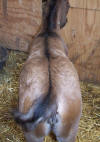 Not Dun Factor A black foal with countershading-caused dorsal and shoulder barring. Click here for proof that this filly is not dun factored. |
|
|
|



Not Dun Factor DNA tested buckskin with NO dun factor gene. |
|
|
|
|
|
|


 Not Dun Factor Super pictures of buckskin foals with countershading stripes that are not caused by dun factor. Notice that the dorsal on these foals stops abruptly at the top of the tail. The foals also do not have ear tips. |
|
|
|

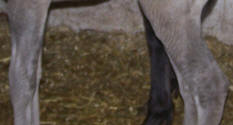 Neither dun factor nor countershading. These are not stripes. This is a hair pattern that shows up best on black and blue roan foals' back legs (and even hips), and that many people mistake for leg bars. It is not, and is probably a trick of lights on waved/curly hair. |
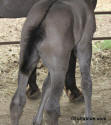
 Not Dun Factor Countershading stripes on black and smokey black foals' legs are fairly common, but disappear over the first year. |
|
|
|
Interesting picture, below. It shows how hard it is to guess horse colors when you can't see "the whole picture" through multiple photos, seeing the horse in person, and/or knowing the sire/dam genetics. Without looking anywhere else but at this photo, what colors do you think these two yearlings (below) are? Click the photo above to enlarge it. Then click HERE to see if you got it right! |
 Click the photo to view it full sized. 3 dun factors, one countershading (non-dun). Can you tell which is NOT a dun factor dorsal stripe?
Click here for the answer.
|
This mare has been DNA tested, and is BUCKSKIN, not dun
or dunskin.
Her test results concluded that she does NOT have a dun factor gene. Her
stripes are amazing, but are apparently caused by another factor (possibly
nd1).
Despite having a dorsal stripe with shading on the side, some leg stripes,
dark tips on the backs of the ears, and even faint cobwebbing on her
forehead, she is not a dun nor dunskin! Thank you for the great pictures,
Kirsty!
UC Davis Information about Dun and Non-Dun Stripes
Three variants in DNA sequence explain phenotypes (how horse "look" to the eye) related to Dun dilution:
-
D (presence of dun dilution and primitive markings)
-
nd1 (not Dun-diluted; primitive markings are present but expression is variable). Think of "nd" meaning "not dun."
-
nd2 (1,617 bp deletion, not Dun-diluted, primitive markings absent). Think of "nd" meaning "not dun."
-
With respect to variant interactions, D is dominant over nd1 and nd2; nd1 is dominant over nd2.
-
The VGL offers a DNA test that will provide information for both dun dilution and the primitive markings. Click here for more information.
This page last updated
08/10/20
If you notice this date being 2 years or older, please let
us know that we need to check out this page!
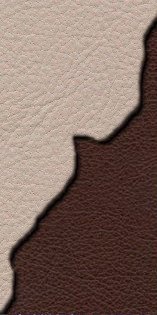
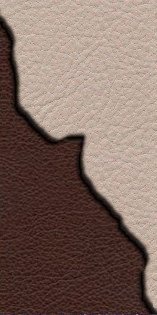
Home Horses For Sale Stallions Mares Foals Blog Color Genetics Riding Horses Site Map Contact Us

Toni Perdew
Bedford, Iowa
toni@grullablue.com
712-370-0851 cell, before 9 p.m. CST
![]()
www.facebook.com/CedarRidgeQuarterHorses
Web design by
CR
Equine Sites.
All rights reserved. Graphics are watermarked for copyright protection.
Terms of Use
